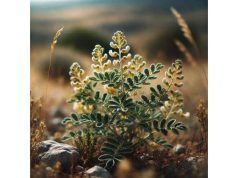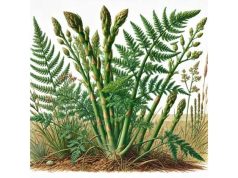
Achiote, scientifically known as Bixa orellana, is a tropical shrub or small tree recognized for its vibrantly colored seeds and significant role in global culinary traditions. Native to the tropical regions of the Americas, this plant bears bright red spiny pods filled with seeds that yield a deep orange-red pigment called annatto. Prized for centuries, Achiote seeds have been used as a natural food coloring, a spice for traditional dishes, and an integral part of cultural ceremonies. Beyond its culinary allure, Achiote offers myriad potential health benefits, partly due to its abundance of bioactive compounds. In diverse cultures, the leaves, seeds, and even the roots have been utilized for a spectrum of applications—from supporting skin health to serving as a natural insect repellent.
Achiote’s significance transcends mere coloring agent status. In various tropical regions, indigenous communities have historically employed the seeds and leaves in herbal remedies, harnessing the plant’s antimicrobial, anti-inflammatory, and antioxidant properties. Modern research is gradually substantiating some of these uses, investigating the possibility that Achiote might aid in lowering cholesterol levels, improving digestion, and even protecting the liver from oxidative stress. Whether used in traditional Mayan face paint or to lend a signature hue to Latin American dishes, this versatile plant holds a unique place at the confluence of cultural heritage, gastronomical innovation, and medicinal curiosity.
- A rich source of natural pigments (annatto) used for coloring foods and cosmetics
- Potential anti-inflammatory and antioxidant activity due to bioactive compounds
- Traditional uses in supporting liver health, digestion, and skin integrity
- Widely used in global cuisines, adding color and subtle earthy flavor to dishes
- Possible cholesterol-lowering and cardioprotective effects suggested by emerging research
Table of Contents
- Achiote: Botanical Insights and Distinctive Plant Traits
- Achiote: Cultural Origins and Traditional Significance
- Achiote: Key Phytochemicals and Their Roles
- Achiote: Health Benefits and Notable Properties
- Achiote: Practical Applications and Safety Guidelines
- Achiote: Noteworthy Research and Scientific Findings
- Achiote: Frequently Asked Questions
Achiote: Botanical Insights and Distinctive Plant Traits
Achiote (Bixa orellana) is an evergreen shrub or small tree from the family Bixaceae. It stands out for its characteristic seed pods, which become covered in spines and transition from green to reddish-brown as they mature. Within these pods lie the seeds coated in a bright red or orange pigment that has fascinated cultures for millennia. Understanding Achiote’s growth patterns, ecological preferences, and morphological traits provides essential context for appreciating its diverse applications.
Physical Description
- Size and Structure: Achiote typically grows between 3 to 6 meters in height. Its branching pattern can appear somewhat sparse, but the plant’s broad, heart-shaped leaves and clusters of vibrant red pods create a visually distinctive presence.
- Leaves: The leaves are simple, oval or cordate (heart-shaped), and can measure up to 15 centimeters in length. Their deep green hue contrasts beautifully with the tree’s bright seed pods.
- Flowers: Achiote produces clusters of delicate, five-petaled flowers, usually white or pink with a yellowish center. These blossoms give way to the spiny seed pods, each containing multiple seeds coated in the iconic red-orange pigment annatto.
- Seeds and Pods: The spiny pods themselves are relatively soft. Upon maturing, they dry and split open, revealing an interior lined with seeds. It is these seeds that have been a focal point of culinary, cosmetic, and medicinal use across numerous cultures.
Native Distribution and Growing Conditions
Achiote is indigenous to tropical regions of Central and South America. However, its appeal has facilitated its spread to multiple continents with similar climates. It thrives in:
- Warm Temperatures: Ideally, Achiote grows best in hot, humid conditions, typically at elevations below 1,200 meters.
- Moist, Well-Drained Soil: The plant favors soils that retain some moisture but are not waterlogged. Proper drainage helps prevent root rot.
- Sunlight Exposure: Full sun or partial shade suffices. Adequate sunlight is crucial for robust pigment production in the seeds.
Cultivation and Propagation
Cultivating Achiote can be straightforward for growers in tropical and subtropical climates. Methods include:
- Seed Germination: Fresh seeds can be germinated in nursery beds. Regular watering and temperatures around 25–30°C help ensure robust sprouting.
- Transplanting Saplings: Young seedlings can be transplanted once they have developed a solid root system. Proper spacing—often around 3 meters apart—allows for optimal growth and easy harvesting.
- Pruning and Maintenance: Minimal pruning is required, typically limited to removing dead or diseased branches. Fertilization with organic matter can promote abundant flowering and seeding.
Ecological Role
Achiote contributes to biodiversity in tropical ecosystems by:
- Providing Food for Wildlife: Birds and small mammals sometimes forage on the plant’s seeds or flowers, aiding in seed dispersal.
- Supporting Pollinators: The plant’s vibrant flowers attract various pollinators, including bees and butterflies, which play a vital role in maintaining ecological balance.
Ornamental and Economic Significance
Aside from its commercial and medicinal merits, Achiote also holds ornamental value:
- Landscaping: With its bright pods and lush foliage, Achiote adds a tropical flair to gardens and public spaces.
- Livelihood for Farmers: The seeds can be harvested for trade, making Achiote cultivation a viable economic enterprise. Its natural pigment remains in high demand in the food and cosmetics industries.
In sum, Achiote’s botanical profile showcases a resilient, visually striking plant well-suited to tropical environments. Its distinctive seed pods, containing the brilliant red annatto dye, have fascinated and served human communities for centuries. Appreciating these botanical details provides the foundation for understanding the plant’s cultural significance, chemical properties, and multifaceted uses.
Achiote: Cultural Origins and Traditional Significance
Achiote’s influence is deeply woven into the fabric of the Americas, particularly among indigenous peoples who have long recognized and harnessed its many attributes. From spiritual ceremonies to everyday culinary practices, the seeds, leaves, and pods of Bixa orellana have played significant roles in shaping cultural identities across the tropics. Tracing the journey of Achiote from ancient traditions to its widespread contemporary use highlights the enduring value and adaptability of this vibrant plant.
Early History and Indigenous Traditions
Anthropological evidence suggests that native civilizations in Central and South America have cultivated and utilized Achiote for thousands of years. Key aspects of its early use include:
- Body Paint and Ritualistic Symbolism: Tribes such as the Maya, Aztec, and other Indigenous groups used Achiote seeds to create a vivid red body paint. This practice served multiple purposes: signifying social status, participating in religious ceremonies, and offering protection against insects.
- Medicinal Remedies: Before the advent of written records, indigenous healers recognized the plant’s potential. They employed the seeds and leaves to treat digestive issues, calm fevers, and maintain skin health, often within a broader context of holistic well-being.
Role in Mesoamerican Cultures
In Mesoamerica, Achiote’s significance expanded beyond its practical applications:
- Culinary Traditions: The seeds of Achiote have long been used as a flavor enhancer and colorant in traditional dishes. In particular, the vibrant red hue of annatto-laced sauces and stews became a hallmark of regional cuisines, symbolizing warmth, celebration, and a connection to ancestral roots.
- Cultural Exchange and Trade: As trade routes developed across Mesoamerica, demand for Achiote seeds grew. Their use as a spice, colorant, and remedy spread, thereby weaving the plant deeper into the economic and social tapestry of the region.
Spanish Colonial Influence and Global Spread
With the arrival of Spanish colonists in the Americas during the 15th and 16th centuries, many native plants, including Achiote, were introduced to Europe and subsequently to other parts of the globe. The seeds, valued for their brilliant color, soon became a sought-after commodity for:
- Textile Dyes: In colonial times, annatto served as a natural dye for fabrics, appreciated for its ability to impart warm, earthy tones to clothing and tapestries.
- Food Coloring in Europe and Asia: Over time, Achiote seeds found their way into international kitchens, particularly in regions keen on adding bright hues to dishes without resorting to artificially produced colorants.
Modern Culinary Integration
Today, the use of Achiote as a food dye and seasoning remains widespread:
- Latin American Cuisine: From cochinita pibil in Mexico’s Yucatán Peninsula to achiote oil used in Puerto Rican and Filipino cooking, the seeds of Bixa orellana impart both color and subtle, earthy flavors.
- Global Gastronomy: Chefs worldwide have embraced annatto’s versatile properties, using it in everything from cheeses and butter to baked goods and marinades. This global acceptance attests to Achiote’s adaptability and enduring appeal.
Ongoing Cultural Significance
Despite modernization, many indigenous communities in Central and South America continue to value Achiote for:
- Cultural Preservation: Rituals and ceremonies that incorporate red body paint or healing salves serve as living links to ancestral knowledge.
- Economic Opportunities: Artisanal crafts, herbal remedies, and agricultural ventures centered around Achiote production foster local economies and reaffirm cultural heritage.
In essence, Achiote’s historical and cultural legacy is as rich as the pigment it provides. From ancient ritual body paint and healing ceremonies to modern culinary masterpieces, the herb’s versatility and symbolic depth remain a testament to its enduring relevance across multiple societies and time periods.
Achiote: Key Phytochemicals and Their Roles
The vibrant red-orange color that defines Achiote’s seeds is the result of a fascinating array of phytochemicals. Though the herb is best known for providing a natural pigment called annatto, Achiote also boasts a spectrum of bioactive compounds that exhibit antioxidant, anti-inflammatory, and antimicrobial properties. Understanding these phytochemicals sheds light on the multiple potential health benefits and industrial uses of Bixa orellana.
Principal Pigments: Bixin and Norbixin
- Bixin: The most prominent carotenoid in Achiote seeds, bixin confers the plant’s characteristic hue. Structurally related to other well-known carotenoids, bixin has garnered attention for potential health-promoting effects. Preliminary studies suggest it might help neutralize free radicals and support skin protection.
- Norbixin: A derivative of bixin, norbixin is water-soluble, making it particularly valuable in various industrial processes. It plays a crucial role in dairy and baked goods industries, imparting color without affecting texture or taste significantly.
Additional Carotenoids and Antioxidants
While bixin and norbixin dominate the conversation about Achiote’s pigments, they are not the sole contributors to the plant’s bioactivity:
- Other Carotenoids: Lesser-known carotenoids in Achiote seeds may also provide antioxidant benefits, helping scavenge free radicals and reduce oxidative stress.
- Tocotrienols and Tocopherols: Some research indicates the presence of vitamin E forms like tocotrienols, known for their role in cardiovascular health and cellular protection.
Essential Oils and Volatile Compounds
Beyond the seed’s pigmented exterior, parts of the Achiote plant, such as its leaves and young shoots, contain a variety of volatile oils. These oils can contribute to:
- Antimicrobial Effects: Certain terpenes and volatile compounds exhibit mild antimicrobial properties, potentially useful for inhibiting the growth of specific bacteria or fungi.
- Therapeutic Uses: Traditional medicine systems often harness these oils in topical preparations for skin irritations and minor wounds.
Tannins and Flavonoids
Achiote leaves and roots also harbor a range of polyphenolic compounds:
- Tannins: Known for their astringent properties, tannins in Achiote leaves may support digestive health when consumed in moderation.
- Flavonoids: These compounds offer antioxidant and anti-inflammatory benefits, complementing the overall therapeutic profile of Achiote.
Pharmacological Synergy
Studies on medicinal plants increasingly underscore the concept of synergy, where multiple compounds work in concert to exert more potent effects than a single agent alone. Achiote is no exception:
- Combined Antioxidant Action: The interplay of carotenoids, tocopherols, and flavonoids can bolster the body’s defenses against oxidative damage.
- Enhanced Anti-Inflammatory Responses: The presence of both lipophilic (fat-soluble) and hydrophilic (water-soluble) compounds in Achiote broadens its potential anti-inflammatory scope across different bodily tissues.
Implications for Product Development
The broad range of phytochemicals in Achiote seeds, leaves, and roots paves the way for:
- Food Industry Applications: Natural colorants derived from the seeds remain in high demand as consumer preference for clean-label ingredients grows.
- Cosmetic and Pharmaceutical Innovations: The antioxidant and antibacterial properties of Achiote’s compounds have attracted attention for skincare formulations, including sunscreens, anti-aging creams, and topical salves.
- Supplementation: Encapsulated extracts of Achiote might find a place in dietary supplements targeting oxidative stress, hepatic support, or digestive wellness.
In summary, Achiote’s key phytochemicals—led by the carotenoids bixin and norbixin—form a complex, synergistic profile of active ingredients. By exploring these compounds in depth, scientists and product developers can harness their health and industrial applications more effectively, bridging the gap between traditional wisdom and modern innovation.
Achiote: Health Benefits and Notable Properties
Achiote has historically been revered for its contributions to food, art, and cultural expression, yet its potential to support well-being is equally compelling. Traditional healers in tropical regions have long prescribed parts of the plant—particularly the seeds and leaves—for a variety of ailments, from digestive issues to infections. Modern scientific investigations, while still evolving, lend credibility to many of these traditional claims. Below is an overview of some of the notable health benefits attributed to Achiote.
Antioxidant and Anti-Inflammatory Actions
Several compounds in Achiote, such as bixin, norbixin, and various flavonoids, exhibit antioxidant properties that help the body combat oxidative stress:
- Neutralizing Free Radicals: By scavenging harmful free radicals, Achiote may reduce cellular damage and inflammation, potentially lowering the risk of chronic diseases.
- Managing Inflammatory Pathways: Research suggests that Achiote may help modulate certain inflammatory markers, supporting overall immune function and reducing discomfort associated with inflammation.
Cardiovascular Support
Preliminary studies indicate that Achiote may offer heart-healthy benefits:
- Cholesterol Regulation: Some animal models have shown that annatto-derived tocotrienols might aid in lowering LDL (“bad”) cholesterol while supporting HDL (“good”) cholesterol levels.
- Blood Pressure Moderation: While not extensively studied, anecdotal evidence from traditional medicine hints that the plant’s leaves may help maintain healthy blood pressure levels.
Liver Health and Detoxification
In various folk medicine systems, Achiote has been employed as a hepatoprotective agent:
- Supporting Liver Function: Antioxidant properties may shield liver cells from toxins and oxidative stress, thus improving liver metabolism.
- Traditional Cleansing Remedies: Indigenous communities have used decoctions of Achiote leaves or seeds to “cleanse” the body, although scientific validation of these claims remains ongoing.
Digestive Well-Being
The leaves of Achiote contain tannins and other compounds that can influence gastrointestinal function:
- Mild Astringent Properties: These can help tighten mucous membranes in the gut, potentially reducing diarrhea and soothing irritation.
- Balance of Gut Flora: Although more research is needed, some herbalists believe Achiote’s antimicrobial properties could support a healthy balance of gut microbiota.
Skin Care Applications
Achiote’s skin-related uses go beyond its role as a natural dye:
- Topical Soothing: Historically, poultices made from the leaves or seeds have been used to alleviate minor burns, rashes, and skin irritations.
- UV Protection: Certain compounds in Achiote have shown promise in providing some level of photoprotection. While not a substitute for commercial sunscreen, the plant’s extracts may offer supplemental defense against harmful UV radiation.
Oral Health
Traditional practices also include chewing Achiote seeds or using leaf infusions for oral care:
- Antimicrobial Effects: The seeds’ bioactive constituents might help neutralize oral pathogens, thus contributing to healthier gums and reduced plaque formation.
- Inflammation Control: Achiote’s anti-inflammatory properties can potentially alleviate minor gum irritations, supporting overall oral hygiene.
Psychological and Emotional Well-Being
Although less commonly discussed, certain ethnobotanical records suggest that Achiote might have mood-supporting effects when consumed as part of a broader herbal regimen. These anecdotal uses typically emerge from holistic traditions that view emotional well-being as closely intertwined with physical health.
In conclusion, Achiote’s array of bioactive compounds offers a multifaceted profile of potential health benefits. Whether used to bolster antioxidant defenses, support healthy digestion, or aid in skincare, Achiote bridges the gap between centuries of traditional wisdom and emerging scientific insights. Nonetheless, further research is necessary to validate these applications fully and delineate safe, effective dosages.
Achiote: Practical Applications and Safety Guidelines
Achiote’s versatility extends well beyond mere food coloring. From the culinary realm to health-related formulations and even textile manufacturing, the various parts of the plant—seeds, leaves, and roots—have been incorporated into an array of products and practices. Despite its broad usefulness, however, one must handle Achiote with due diligence to ensure safe and optimal results.
Culinary Uses and Techniques
Achiote seeds, known commonly as annatto, are widely embraced in global cuisine:
- Flavoring and Coloring:
- Annatto Oil (Achiote Oil): Prepared by gently heating the seeds in a neutral oil until the oil adopts a deep orange hue. Used in sautéing or as a marinade base.
- Annatto Paste: In certain Latin American cuisines, the seeds are ground and blended with spices (garlic, cumin, oregano) to create a paste for stews, rice dishes, and meats.
- Dish Enhancement:
- Color Addition: Cheeses (like cheddar), butter, and baked goods often contain annatto for aesthetic appeal.
- Subtle Earthy Flavor: The seeds impart a mild, slightly peppery taste.
Medicinal and Home Remedies
Beyond the kitchen, Achiote is a mainstay in many folk medicine practices:
- Herbal Teas and Decoctions: Infusions of the leaves may be consumed to support digestive health or soothe mild inflammation.
- Topical Pastes: Ground seeds or leaf extracts applied to the skin can address minor irritations or serve as a natural insect repellent.
- Capsule Supplements: Standardized extracts are sometimes marketed for antioxidant or hepatoprotective support, although reliable dosage guidelines vary.
Industrial and Cosmetic Applications
Achiote’s vibrant pigments and bioactive potential have attracted interest from industries such as:
- Textile Dyeing: Historically, Achiote was used to color fabrics in warm yellow to reddish hues. Although synthetic dyes now dominate, artisanal communities still employ Achiote for natural dyeing processes.
- Cosmetics and Skincare: Formulations that aim to harness antioxidants and mild antibacterial properties may include Achiote extracts. From lip balms to lotions, annatto derivatives contribute to both coloration and potential protective benefits.
Dosage Considerations
While Achiote is generally regarded as safe when consumed in typical food amounts, specific circumstances call for prudence:
- Supplement Formulations:
- Professional Guidance: Individuals considering high-concentration extracts for therapeutic use should seek advice from a qualified healthcare provider or herbalist.
- Follow Label Instructions: Overconsumption can lead to unverified side effects.
- Prolonged or Excessive Use:
- Lack of Long-Term Data: While the plant has a long history of safe use in moderate quantities, less is known about high-dose or extended consumption.
Potential Side Effects and Precautions
Achiote’s safety profile is favorable, yet certain people should be cautious:
- Allergic Reactions: Some individuals may experience skin irritation or mild gastrointestinal discomfort. A patch test or starting with small dietary amounts can help detect adverse reactions.
- Medical Interactions: People on specific medications—such as those for high blood pressure or hyperlipidemia—should consult their healthcare provider before incorporating Achiote supplements.
- Pregnancy and Breastfeeding: Although commonly ingested in normal food preparations, higher therapeutic doses should be approached with care and professional consultation.
Storage and Shelf Life
To preserve the quality and potency of Achiote products:
- Seed and Powder: Keep in airtight containers away from direct light and moisture.
- Oil and Extracts: Store in cool, dark conditions to slow oxidative processes and maintain vibrant color.
By adhering to these guidelines, users can fully appreciate the functional and flavorful characteristics of Achiote while minimizing risks. As with any herbal remedy, moderation, informed usage, and a respect for cultural traditions and current scientific findings are paramount in maximizing its benefits.
Achiote: Noteworthy Research and Scientific Findings
Modern science has taken a keen interest in validating and elucidating the therapeutic claims long associated with Achiote. While research on Bixa orellana remains relatively limited compared to more extensively studied botanicals, a growing number of studies have begun to shed light on its diverse potential. Below is an overview of significant findings that offer insights into the plant’s pharmacological attributes.
Key Studies and Their Contributions
- Antioxidant and Free Radical Scavenging (2018)
- Journal & Title: Published in the Journal of Medicinal Food, “Evaluation of the Antioxidant Potential of Bixa orellana Extracts”
- Findings: Laboratory models demonstrated that annatto extract exhibited notable free radical scavenging activities. These results lend support to traditional assertions that Achiote may help mitigate oxidative stress in the body.
- Hepatoprotective Effects (2019)
- Journal & Title: Featured in Phytotherapy Research, “Protective Role of Annatto Extract Against Induced Hepatotoxicity in Rodent Models”
- Findings: Rodents administered with standardized annatto extract showed reduced liver damage markers when exposed to hepatotoxins. This suggests the herb’s potential utility in supporting liver function and reducing oxidative strain.
- Tocotrienols and Cardiovascular Health (2020)
- Journal & Title: Reported in the Nutrients journal, “The Impact of Annatto-Derived Tocotrienols on Cholesterol and Cardiovascular Parameters”
- Findings: A human clinical trial involving annatto-based tocotrienol supplementation indicated modest improvements in total cholesterol and LDL levels, pointing to a possible role for Achiote compounds in cardiovascular maintenance.
- Antimicrobial Properties (2021)
- Journal & Title: Appearing in the Journal of Ethnopharmacology, “Bixa orellana Extracts as Antimicrobial Agents Against Common Pathogens”
- Findings: In vitro experiments revealed that Achiote leaf extracts displayed inhibitory effects on certain bacterial strains, suggesting potential for the herb’s use in natural antimicrobial formulations, pending further research on formulation and efficacy.
Areas of Emerging Interest
- Anti-Inflammatory Mechanisms: Recent work aims to clarify the molecular pathways through which the plant’s carotenoids and polyphenols may help regulate inflammatory responses.
- Nutraceutical Integration: The rise of functional foods has sparked interest in incorporating annatto extracts into bars, beverages, and dietary supplements that target heart and liver health.
- Sustainable Pigment Production: Environmental concerns drive ongoing studies on optimizing cultivation practices and extraction methods for natural dyes, with Achiote being a frontrunner in this sector.
Achiote: Frequently Asked Questions
What is Achiote, and how is it used?
Achiote, also known as annatto or Bixa orellana, is a tropical plant whose seeds are famous for yielding a vibrant, natural pigment. It is commonly used to color and flavor foods, create cosmetic dyes, and in traditional herbal remedies for potential health benefits.
Does Achiote offer any health benefits beyond coloring food?
Yes. Achiote contains carotenoids like bixin and norbixin, which may provide antioxidant, anti-inflammatory, and liver-protective effects. Some studies also suggest that tocotrienols derived from the plant could help manage cholesterol levels.
How do I incorporate Achiote into cooking?
Achiote seeds can be heated in oil to produce a brightly colored annatto oil, or they can be ground to make achiote paste. This oil or paste can then be used in dishes like rice, stews, and marinated meats, imparting a distinct hue and subtle earthy flavor.
Are there safety concerns with using Achiote?
Achiote is generally safe in regular food amounts. However, individuals with allergies or chronic conditions should consult a healthcare provider before using concentrated extracts or supplements. Pregnant and breastfeeding women should also seek professional advice prior to high-dose usage.
Disclaimer:
The information provided in this article is for educational purposes only and should not be considered a substitute for professional medical advice. Always consult with a qualified healthcare provider before making any changes to your dietary, supplement, or health regimen.
If you found this article useful, please share it on Facebook, X (formerly Twitter), or your favorite social media platform to help spread the word about the remarkable versatility and benefits of Achiote!










